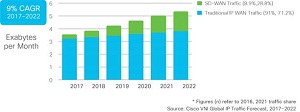News
Cisco Forecasts Exploding SD-WAN Traffic
Cisco has released its big annual Visual Networking Index (VNI) report, which forecasts a huge rise in IP traffic, much of it driven by the exploding software-defined wide-area network (SD-WAN) market.
SD-WAN growth provides perhaps the most visible sign of the disruptive, game-changing software-defined networking (SDN) movement making inroads into the enterprise.
SD-WANs are an increasingly active segment of the SDN movement, which sees more open, interchangeable software solutions overtaking legacy, proprietary, hardware-based systems. Purported benefits include agility and flexibility, lower costs and increased performance. As the SDN movement matures from early testing and proof-of-concept efforts in academia and test labs -- mostly targeting major service providers and carriers -- SD-WAN solutions are providing an entryway into the enterprise networking space.
In the comprehensive and wide-ranging Visual Networking Index, Cisco identifies SD-WAN as a major force behind skyrocketing network utilization, which it said will result in more IP traffic over the wires in the next five years than in the entire history of the Internet. "In other words, more traffic will be created in 2022 than in the 32 years since the Internet started," the company said.
And SD-WAN will be at the forefront of that traffic increase.
"SD-WAN traffic will grow at a CAGR of 37 percent compared to 3 percent for traditional MPLS-based WAN," the report states. "SD-WAN will increase 5-fold and will be 29 percent of WAN traffic by 2022."
 [Click on image for larger view.] Global Enterprise SD-WAN Traffic (source: Cisco).
[Click on image for larger view.] Global Enterprise SD-WAN Traffic (source: Cisco).
To be sure, SD-WAN growth will be helped by several other trends in boosting IP traffic, including the increasing usage of gaming, video, virtual and augmented reality and more.
The Internet of Things (IoT) will also play a big part. "Globally, more than half of the things that will be connected to IP networks will not be our personal devices (smartphone, tablets, PCs and TVs), but sensors, tracking modules, cameras and other forms of machine-to-machine (M2M) connections that gather and share various types and volumes of information with other machines," Cisco said a blog post yesterday (Nov. 27). "In previous VNI Forecasts, the traffic generated from IoT applications was practically negligible (less than 5 percent of global traffic). With more bandwidth-intensive (and low latency) applications like autonomous driving smart cars, video surveillance, and connected health, IoT traffic now needs to be accounted for, secured and managed in new ways."
Here are some more highlights from the report:
- Global IP traffic will more than triple
- Global Internet users will make up 60 percent of the world’s population
- Global networked devices and connections will reach 28.5 billion
- Global broadband, Wi-Fi and mobile speeds will double or more
- Video, gaming and multimedia will make up more than 85 percent of all traffic
More information on the report, including its purpose and methodology, can be found here.
About the Author
David Ramel is an editor and writer at Converge 360.